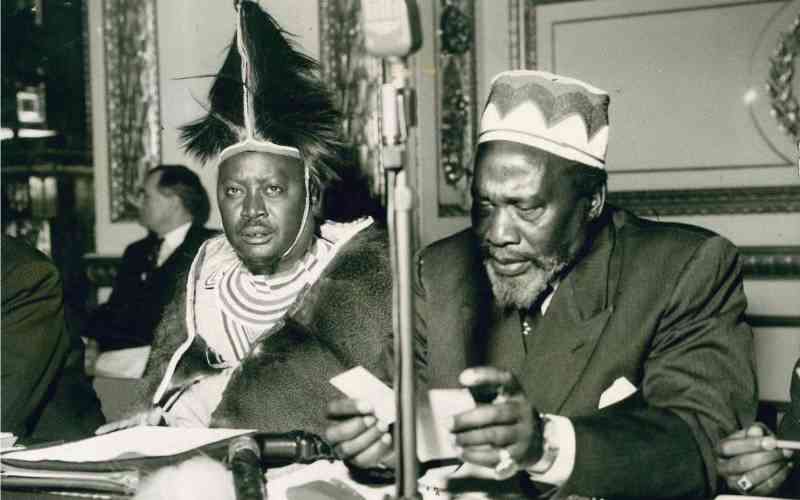By Amos Kareithi
Scared of a major uprising and aware of the influence a tiny community had over the residents of Kericho and Nandi, the colonial government in 1934 crafted a law to confine about 700 members of the Talai clan in an open-air jail.
The ordinance, which has been likened by historians to Adolf Hitler’s policy of isolating the Jews before herding them into the gas chambers was consented by King George V and was implemented on in September 1934.
The Passing of the law was hastened by the attack of a European settler couple, Alex and Stella Semini of Kinangop, whose home was burgled, the owners assaulted and guns stolen triggering widespread fears after the man died.
Police investigations determined that the attack had been perpetrated by eight Kipsigis, which made the settlers more hostile towards the community.
Historian, David M Anderson, in his work, Black Mischief: Crime, Protest and Resistance in Colonial Kenya, explains the attack followed a wave of increased insecurity in Nandi and Kipsigis lands where theft of guns ammunition had spiraled as more and more settlers were targeted.
In 1934, Kericho District Commissioner Douglas Brumage conducted investigations, which showed systematic organisation of the Kipsigis communities under the spiritual guidance of their Laibons in readiness for a major showdown with the colonialists.
Brumage’s final report uncovered the extent of “organised crime” sanctioned by the Laibons and recommended the removal of the entire Talai clan from the Kipsigis reserve as, “they had evil influence on the whole population.”
Consequently in May 1934, the Attorney General William Harrigan drafted legislation ‘The Laibons Removal Ordinance’ (no. 32 of 1934) to provide for the mass deportation of the Talai clan, and forwarded it to London for approval.
After heated deliberations during which 39 affidavits allegedly signed by some members of the Talai, attesting to the alleged “evil powers of the Laibons” were tabled in the Legislative Council, as the Bill was unanimously passed into law.
It ultimately became law on September 25, 1934 after it was operationalised by the then acting Colonial Secretary, Juxton Barton proclaiming: “In exercise of the powers conferred upon me by section 1 of the Laibons Removal Ordinance,1934, I do hereby appoint the 25th day of September 1934 as the date upon which the said ordinance shall come into operation. God save the King.”
The ordinance which was divided into 20 sections, defined a Laibon as an Orkoiyot, who to the colonial authorities meant, “an adult male member of Talai clan? resident in the South Lumbwa or Nandi district.”
The removal envisioned by the law was “removal to the settlement area and compulsory settlement in the “rocky area with high hills’ on the shores of Lake Victoria at Mung’ori Bay, which the ordinance described as “cairn.”
The land where the Laibons were to be removed included Mfangano Islands, Kericho and, Kapsabet townships.
Under the ordinance the Provincial Commissioners of Rift Valley and Nyanza were granted sweeping powers to take the fingerprints of all the members of the Talai clan for the purposes of compiling a register.
Stay informed. Subscribe to our newsletter
The PC had the powers to demand answers to questions of ancestry from any person suspected to be a Talai and he, alone, could declare one a Laibon and cause him to be removed to Gwassi or other concentration camps.
“Any person who is aggrieved by any entry relating to him of his family made or proposed to be made in a register may appeal to the PC against such entry,” reads section 8 (5) of the ordinance. The law further gave the PC powers to establish concentration camps to collect and detain the Laibons and their families therein and also organise compulsory movement of the Laibons and their livestock.
Section 10(c), was meant to deter any escape as the PC was given powers to: “To arrange for the guarding of the Laibons and their families in camps or temporary halting places to prevent their escape.”
The Law was very harsh on any member of the clan who withheld any information concerning their parentage and ancestral background and provided for the arrest of such individuals without a warrant who upon conviction could be jailed for six months or fined a maximum of Sh300.
?It was also a criminalised to move out of the designated detention camp or settlement without written permission from the PC.
?“Every Laibon and every member of the Laibon’s family so removed to and settled in the settlement area shall thereafter be restricted in his movement to the boundaries and is hereby prohibited from moving out of such area at any time unless he is in possession of a pass granted by the PC in accordance with section 14 of this ordinance.”
It provided that, “If a person removed and settled under this act?leaves the settlement area without written authority of the PC, such a person shall be guilty of an offence and may be arrested without a warrant.”
The law further provided that such an offender upon conviction be jailed for a term not exceeding one year, but if the offence was repeated the maximum sentence was set to be doubled, while the fines stipulated were quite prohibitive and was fixed at Sh1,000.
While the bill was being debated in the legislative assembly, the chief Native commissioner gave a background of the Talai whom he said had originated from Segala Masai from where their forefathers had fled to avoid being killed.
He told a hushed house the Laibons had medicine men, who had powers of divining by casting stones, inspecting entrails and interpretation of dreams and could also make rain.
This, the assembly heard, was the reason they were consulted by the Nandi and the Lumbwa before? all important events? like making of war, planting of crops? and generally acted as the brains behind the? all important actions of the tribe.
“The removal of the Laibons, has been necessitated by a number of petitions some by 467 members of the leading Lumbwa tribe and strangely by the Laibons who asked to removed provided they were not taken too far away from their own reserve,” the commissioner added.
After presenting a long list of crimes committed by the Laibons to the house, the Native commissioner had pleaded with his colleagues to support the bill, claiming “it was the last desire of the government to send these people to a place that will not be suitable.”
Some MPs, however, doubted the sincerity of the government and the charges that the Laibons ran an extortion racket where all people were supposed to pay tribute.
“If they have been receiving tribute, these Laibons would have been extremely wealthy. It is strange that a community of 700 people have something like 3,000 head of cattle between them that is to say they have about four heads of cattle per individual,” an MP argued.
Even as the removal of Laibons Ordinance of 1934 condemned the Talai to a settlement in Gwassi, the Legislative Council members were aware that this was like a death chamber for a pastoral community being forced out of the highlands into Lambwe valley.
One member told the council that the area chosen for settling the Talai was unsuitable as it was infested with tsetse flies where sleeping sickness was rampant. It was described as valley of death where 30 years earlier, 60 percent of the inhabitants of Lambwe valley had been killed by diseases.
It seemed, according excerpts of the debate, the government was using the ordinance to provide a biological method of exterminating the Talai clan.
A member opposed to the ordinance is quoted saying, “I believe it is a fact that the Laibons cannot intermarry with the residents of South Kavirondo reserve. That is to say they have to procure their wives from other parts of Lumbwa and if they are kept from contact with, they can only procure wives from among themselves and naturally they will die out.”
This tallies with a letter written 13 years after the Talai were moved to Gwassi when he unapologetically proposed that all the elderly clan members be left to die in Nyanza so that a new generation, who are obedient to the government would be nurtured.
Reacting to reports that one of the Laibons had been frequenting Gwassi too often,?the DC retorted on November 13, 1943, “I think we should face up to the fact that we should concentrate on the children and brutal as it may seem leave the old men to die out gradually in Gwassi. I have little sympathy for the actual age group who made life so difficult for the government.”
 The Standard Group Plc is a
multi-media organization with investments in media platforms spanning newspaper
print operations, television, radio broadcasting, digital and online services. The
Standard Group is recognized as a leading multi-media house in Kenya with a key
influence in matters of national and international interest.
The Standard Group Plc is a
multi-media organization with investments in media platforms spanning newspaper
print operations, television, radio broadcasting, digital and online services. The
Standard Group is recognized as a leading multi-media house in Kenya with a key
influence in matters of national and international interest.
 The Standard Group Plc is a
multi-media organization with investments in media platforms spanning newspaper
print operations, television, radio broadcasting, digital and online services. The
Standard Group is recognized as a leading multi-media house in Kenya with a key
influence in matters of national and international interest.
The Standard Group Plc is a
multi-media organization with investments in media platforms spanning newspaper
print operations, television, radio broadcasting, digital and online services. The
Standard Group is recognized as a leading multi-media house in Kenya with a key
influence in matters of national and international interest.





